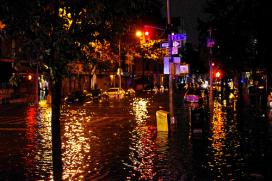Volpe Supports Hurricane Sandy Relief Efforts, Helps Overcome Transportation Challenges
With Hurricane Sandy bearing down on the northeastern U.S., Volpe community planner Terry Sheehan was directed to report to the Regional Response Command Center in Maynard, MA, as the U.S. DOT Regional Emergency Transportation Representative for Region 1.
Sheehan, a part of Volpe's Center for Transportation Logistics and Security, was responsible for coordinating the transportation of life saving and life sustaining supplies such as food, water, blankets, and generators to affected areas, coordinating the movement of utility crews from other states to affected areas, and assisting in organizing housing for responders who were sent on-site.
When it became clear that the brunt of the storm was in New York and New Jersey, Sheehan reported to a NYC Emergency Operations Center at the base of the Brooklyn Bridge. The overarching priority was to respond to the needs of afflicted New Yorkers, and to ensure they were given access to available transportation, fuel, shelter, and medical assistance and relief supplies.
Sheehan focused his efforts on getting resources where they were needed as quickly as possible. Some examples of the challenges he faced in this large-scale response effort include:
- Many of the trucks heading into New Jersey and New York State carrying a portion of the one million meals and one million liters of water that were required each day weighed more than the maximum weight allowed on some roads. Permits needed to be expedited to allow these trucks to travel on state and federal roads. In addition, oversize and overweight life sustaining cargo such as transformers and power substations needed coordination to traverse the country and arrive safely at their destination. Working with the American Association of State Highway Transportation Officials (AASHTO), state permit office staff worked extra hours to issue the permits.
- Utility crews from Ohio were eager to support response efforts, but their trucks were not approved for interstate travel. Through coordination between federal and state agencies, permits were secured to enable these trucks to cross state lines.
- With hundreds of volunteers from many organizations traveling house-to-house in hard hit areas assisting people in need of aid, and hotels fully booked in the NY area, appropriate and safe shelter needed to be provided quickly for these volunteers. The U.S. DOT Maritime Administration (MARAD) provided three ships from their Ready-Reserve fleet, providing over 1,500 berths, as well as hot meals and showers.
- Trucks coming from various parts of the country needed assistance to bypass some bridge tolling—the toll for a large truck crossing the Verrazano-Narrows Bridge can exceed $100.
- Getting trucks to the designated staging area in Brooklyn required that a hotline be set up so truckers could obtain routing information so they did not end up on parkways with low clearance bridges, or narrow city streets. In addition, escorts were arranged so some trucks could maneuver through areas with no street lights or working traffic signals and arrive at their destination safely.
- With fuel in short supply, a fueling point needed to be established for first responders so they could move freely to affected areas. This required coordinating with FEMA, Defense Logistics Agency and gas delivery companies.
- There was a need to find appropriate staging areas for FEMA-supplied temporary housing units. Sheehan worked with his counterparts to find abandoned airfields in New York and New Jersey that could be used to stage these units and secure permits and waivers to move these units from Maryland and other areas throughout the country.
When disaster strikes, Volpe's Terry Sheehan deploys.
Each disaster is unique, but rapid response is always critical. Quick-thinking experts like Sheehan are well-versed in facilitating the rapid transport of life-saving and life-sustaining supplies, making a huge difference for the people who are most affected by a disaster.

